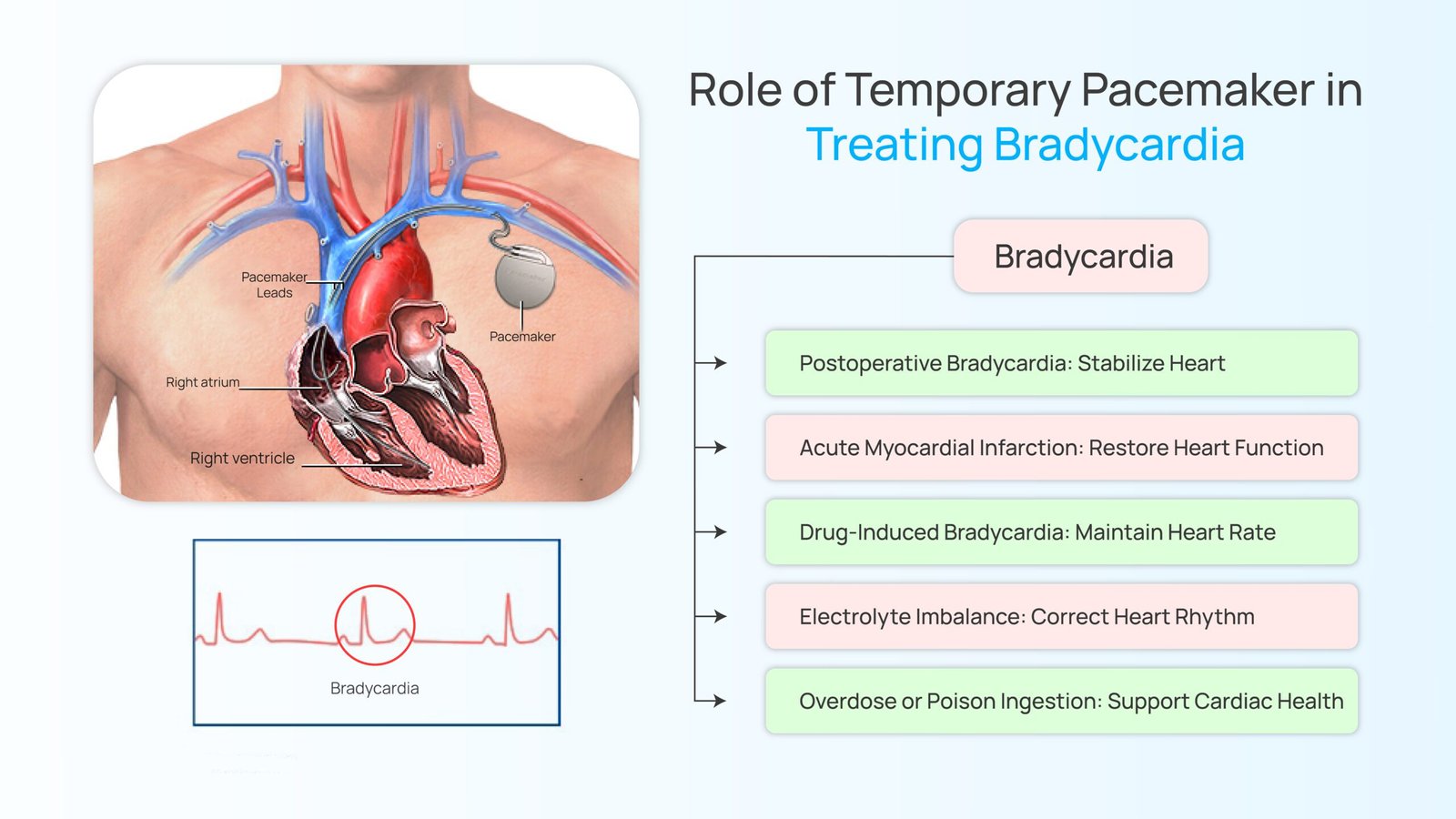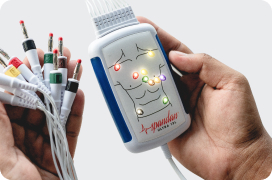
Related Products
Related Article
Author:- Mr. Ritesh Sharma
Bradycardia is a type of arrhythmia (irregularities in the heart rhythm) characterized by a slow heart going below the normal range of 60 beats per minute. There is a very significant role of temporary pacemaker in treating bradycardia. In severe cases of bradycardia, the heart reaches the stage where it almost stops beating or beats at a very slow rate. In such a scenario, a temporary pacemaker comes in handy.
Bradycardia is identified through an abnormal ECG showcasing being tested. Unlike Tachycardia which mostly causes fleeting problems such as heart palpitations, bradycardia requires prompt intervention because it can cause serious conditions such as a heart block. Hence, a device like a temporary pacemaker is readily utilized in the condition of medical emergencies.
The pacemaker regulates the heartbeat properly and the electrical activity of the heart is revived through it. Let’s learn more about the role of temporary pacemaker in treating bradycardia in this blog below.
Role of Temporary Pacemaker in Treating Bradycardia
Understanding Pacemakers
Before delving into the role of temporary pacemaker in treating bradycardia, let’s try to understand what pacemakers are. Pacemakers are electronic devices that are implanted in the chest or abdomen of humans. These devices primarily monitor heart rate and when required deliver electrical impulses to maintain a proper heart rhythm. While for long-term management of bradycardia, permanent pacemakers are used, temporary pacemakers provide you with an immediate solution until the permanent pacemakers can be implanted.
The Basics of a Temporary Pacemaker
The role of temporary pacemaker in treating bradycardia becomes crucial because they are conventionally utilized in emergency situations. The good part about having a temporary pacemaker is that it requires no surgery for implantation. Instead, these pacemakers can be directly into the heart through a catheter. Through these devices, the heart receives electrical stimulation that overpowers the slow or irregular heartbeats associated with the cardiac arrhythmia bradycardia.
Indications for Temporary Pacemaker Placement
There are different conditions where bradycardia poses an immediate risk to the patient. In such a condition, the role of temporary pacemaker in preventing bradycardia becomes crucial. Let us understand the situation that indicates temporary pacemaker placement:-
- Postoperative Bradycardia: After having undergone an operation, patients might experience temporary disruptions in the heart rhythm. This could occur due to anesthesia or surgical trauma. In such a condition, temporary pacemakers can stabilize the heart rate and make the recovery period seamless.
- Acute Myocardial Infarction (Heart Attack): In a few cases of acute myocardial infarction, the electrical conduction system of the heart has to face the consequences. This leads to a complete blockage in the heart sometimes. Therefore, in such cases, temporary pacemakers are used to salvage the situation, until the exact underlying cause is identified.
- Drug-Induced Bradycardia: There are a few medications such as beta-blockers or calcium channel blockers that can potentially cause bradycardia as a side effect. In such conditions, temporary pacemakers are used until the healthcare professional considers alternative medications or other interventions.
- Electrolyte Imbalance: Some electrolyte imbalances, such as potassium and magnesium can cause chaos in the electrical activity of the heart and lead to bradycardia. In this condition, the temporary pacemakers can stabilize the rhythm of the heart until a solution to balance the electrolytes is found.
- Overdose or Poison Ingestion: In cases where you have an overdose of drugs or ingested poison, bradycardia occurs due to toxic effects on the heart. If this happens, temporary pacemakers are used to support cardiac function until the toxins of the drugs or poison are eliminated from the body.
Risks and Considerations
While the role of temporary pacemaker in preventing bradycardia is significant, it doesn’t come without potential risks. The temporary pacemakers contain inherent risks that must be considered prior to using them to regular your heart rhythm.
- Infection: The risk of infection is prominent in any invasive medical procedure and implantation of temporary pacemakers in bradycardia is no different. In this condition, the groin in the neck usually becomes infected. Due to this conditions like swelling, prolonged pain, redness, and fever can occur. This is why it is important to adhere to aseptic techniques during insertion of pacemakers. Apart from this, careful monitoring for signs of infection is also necessary to ensure the seamlessness of the procedure.
- Bleeding: In the process of temporary pacemaker implantation, the pacing wires are inserted in the blood vessels or heart chambers. This process can cause bleeding ranging from minor bruising to life-threatening hemorrhage. Patients who receive anticoagulant or antiplatelet medications are at a higher risk of bleeding. Hence, doctors might carefully assess these patients before performing the implantation procedure.
- Vascular or Cardiac Perforation: If the pacing wires are inserted improperly, it can cause perforation of blood vessels or heart tissues. Due to this, there could be serious complications such as hemopericardium (bleeding into the pericardial sac), cardiac tamponade (compression of the heart due to fluid accumulation), or vascular injury. Therefore, it becomes essential to perform the procedure of implantation meticulously.
- Dislodgement: Sometimes, the pacing wires may get dislodged from their intended position causing arrhythmias of different arrhythmia classification. Dislodgement normally occurs due to patient movement, coughing, or manipulation of the pacing wires. Therefore to prevent dislodgement, the healthcare professional must ensure the proper fixation of wires and patient immobilization.
- Medical Complications: In the temporary pacemaker implantation process, electric components and pacing wires are used. These equipments can break or malfunction leading to potential medical complications. Hence, the doctors must ensure the immaculate state of all these equipments, prior to performing the implantation process.
- Psychological Impact: The person who has the temporary pacemaker implanted might face psychological distress and adjustment difficulties. Life post-implantation of a temporary pacemaker becomes difficult. In such a condition, the patient must learn to cope with it and minimize the psychological impact by taking proper guidance from his/her healthcare professional.
In conclusion, when immediate medical attention is required in the case of bradycardia, temporary pacemakers become essential. They can provide you with a temporary solution until the other underlying medical conditions are determined or the requirement for a permanent pacemaker arises. The implantation of temporary pacemakers is an invasive process and it comes with its risks and complications. Hence, the healthcare professional and the patient must ensure that the process takes place meticulously.





